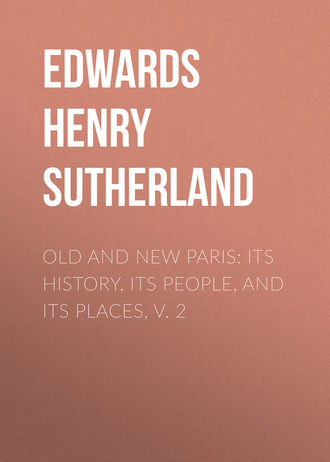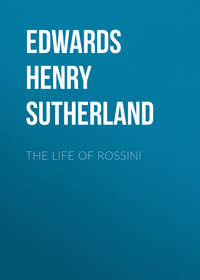 полная версия
полная версияOld and New Paris: Its History, Its People, and Its Places, v. 2
Catherine II. granted Diderot a handsome pension, and she at the same time purchased his library for a large sum. The empress went so far, indeed, as to send him the sum of 50,000 francs, being the annual pension paid in advance for fifty years. Touched by the bounty of Catherine, Diderot wished to thank the empress in person, and in the year 1773 he started for Russia. At the Hague he was met by the High Chamberlain, Narischkin, who, accompanying him to St. Petersburg, put him up at his own house. Diderot’s friend Grimm was already at St. Petersburg. He presented Diderot to the Empress Catherine, who received him in the most cordial manner. She would be glad to see him, she said, in her own apartments every day from three to five or six, and she took the greatest pleasure in his conversation. “I see him very often,” she wrote to Voltaire. “Our conversations are incessant. What an extraordinary head he has! As for his heart, would that all other men had one like it. I do not know whether they (Grimm and Diderot) are getting tired of St. Petersburg, but I know that I could talk to them all my life without fatigue.”
Catherine did her best to keep Diderot at St. Petersburg; but he wished to return to Paris, and though he had been invited to stay at Berlin by Frederick the Great, he passed through Prussia without visiting the capital. It has been before said that he had no sympathy for Frederick.
Soon after his return to Paris he was taken ill, and after a short malady died. The curé of Saint-Roch had come to see him, and Diderot received him in a very friendly manner. They talked on various moral and religious subjects, and as they agreed on many theological points, especially as to the efficacy of charity and good works, the curé ventured to suggest that if he would authorise the publication of these opinions, together with a retractation of his works, the effect would be excellent. But Diderot would do nothing of the kind. Neither would he confess. Nevertheless there was but little difficulty in connection with his funeral, which took place at Saint-Roch, where he was buried (July, 1784) in the Chapel of the Virgin. There his remains still lie.
CHAPTER XXXIV.
MONSEIGNEUR AFFRE AND THE INSURRECTION OF JUNE
The Courtyard of the Dragon – The National Workshops – The Insurrection of June – Monseigneur Affre Shot at the Barricade of the Faubourg St. – AntoineCLOSE to the Rue de Turenne is the Courtyard of the Dragon, inhabited for the last two centuries, even until now, by dealers in every kind of ironwork. It was here, in July, 1830, that the first insurgents of this particular district armed themselves more or less effectively for the fray. The Courtyard of the Dragon owes its name to the dragon in bronze placed at the entrance, just opposite the Rue Sainte-Marguerite, in allusion to the monster on which painters and sculptors make Sainte Marguerite trample. Passing in front of the Courtyard of the Dragon the Rue de Rennes runs from north to south. The Rue du Four, the Rue du Vieux-Colombier, and the Rue d’Assas, are at the back of the Monastery of the Carmes Déchaussés – or Shoeless Carmelites – which occupies the interior of the angle formed by the Rue de Rennes and the Rue d’Assas. The Shoeless Carmelites, as formed or reformed under the auspices of St. Theresa, were authorised to establish themselves in France by letters patent, dated June, 1610; and they soon enriched themselves by the sale of two manufactured articles which they alone were able to make: a kind of stucco, known as Blanc des Carmes, which took the polish of marble, and treacle water; both of which became very popular in Paris. The Carmelite Monastery is now the seat of the Catholic University of Paris, founded by thirty French archbishops or bishops, and comprising three faculties: Law, Letters, and Sciences. In 1791 the priests, who had refused to swear fidelity to the Constitution, were imprisoned in the Carmelite Monastery, and the massacring band of Maillard, and the wretches under his orders, slaughtered them on the 2nd and 3rd of September, 1792, together with all the prisoners, irrespectively of age or sex, who were confined with them. Close to the altar of the left transept is a monument enclosing the heart of Monseigneur Affre, who fell during the terrible days of June, in 1848, at the formidable barricade of the Faubourg St. – Antoine, as he was making a last effort to stop the further effusion of blood. In the midst of his exhortations he was struck in the loins by a stray bullet, and fell into the arms of the insurgents, who were in despair at the terrible incident, which was not the result of a crime, as the direction of the shot, the evidence of the vicars in attendance upon him, and the grief of the revolutionists sufficiently testified. The venerable prelate expired on the 27th, two days after he had been struck. “May my blood be the last shed” were his dying words.
The successful insurrection of June, which, after much slaughter, was suppressed, was partly the consequence of the successful insurrection of February, after which, Louis Philippe having taken flight, the Second Republic was proclaimed. In February the provisional Government had guaranteed in a formal manner the “right to labour.” Accordingly, numbers of workmen being without employment, and capitalists being unwilling to embark in new enterprises, or even in many cases to continue those which were already on foot, national workshops were opened, in which upwards of 100,000 workmen found occupation and bread. Apart from the drain upon the exchequer caused by the employment of these hundred thousand men, the inevitable moment at which it would be necessary to close the workshops was regarded by everyone with alarm. Each workman was employed one day out of four in useless labour; and the more prudent hoped that the national workshops would be closed gradually, and the men induced gradually to seek service with private employers. Among other measures it was proposed to colonise Algeria with the men out of work; and it was calculated that two hundred millions of francs would be necessary for this purpose. According to the calculations of many wise economists and politicians, an expenditure of two hundred millions in order to get rid of a menacing army of 100,000 men was not excessive. Others, including, it may be, some secret enemies of the Republic, who did not object to a violent collision, in which the republican form of government might disappear, thought the workshops ought to be closed, and the men left to shift for themselves. The national workshops were at the same time declared to be nests of idlers, thieves, and incendiaries.
On the 17th of June, after long and passionate debates in the Assembly, the immediate dissolution of the national workshops was proposed. The next day the workmen, by way of reply, exhibited on all the walls of Paris placards in these terms: “There is no unwillingness on our part to work; but useful and appropriate work according to our trades is just what we cannot obtain. We call for it, we ask for it with all our force. The immediate suppression of the national workshops is demanded; but what is to become of the 100,000 workmen who find in their modest pay the sole means of existence for themselves and their families? Are they to be delivered over to the evil counsels of famine, to the suggestions of despair? Are they to be placed at the mercy of factions?” A proclamation was at the same time issued to the workmen, calling upon them to be calm, and warning them against the emissaries of different political parties. “Nothing is any longer possible in France,” concluded the proclamation, “but the democratic and social republic. We will have neither emperor nor king; nothing except liberty, equality, and fraternity.”
It was decided in the first place to expel from the national workshops, and, with the consent of the expelled, enroll in the army all workmen of from seventeen to twenty-five years of age. Other detachments were to be sent to the marshes of Sologne in order to drain them, or to be employed on earthworks in distant departments. Others, again, could be sent to Algeria. The workmen, however, showed no disposition to adopt any of the courses recommended; and, according to the expression of one of them, they were called upon to choose between famine, expatriation, and military servitude. They were threatened, indeed, by famine, but more than one means of escape was offered to them. After a stormy day an immense meeting was held in the Place St. – Sulpice, at which, after many impassioned speeches, it was decided to meet the next morning at six o’clock in the Place du Panthéon. The executive commission appointed by the Government to watch over the peace of Paris, and prevent, if possible, its being broken, ordered General Cavaignac, Minister of War, to occupy the Place du Panthéon the next morning, June 23rd, at five. But at six not a soldier was to be seen, and the square was taken possession of by the people. The absence of troops at important points was observed elsewhere. Two plans had been discussed. The executive commissioners wished the troops to be disseminated in such a manner that no barricade could be erected without being at once destroyed, so that the hostile popular movement would be crushed from the beginning. Cavaignac, however, wished to be allowed to mass the entire army beneath his orders, and then to send columns of attack wherever necessary. It was represented to him that by such a system Paris would be covered with barricades, and the final victory of the troops cause torrents of blood. The stern soldier cared nothing for that. “As for the National Guard, let it take care of its own shops,” he haughtily added; “I do not wish to run the risk of a single one of my companies being disarmed.” Cavaignac was afterwards accused of having purposely allowed the insurrection to grow, in order that he might play the part of a saviour. But the question being purely a military one, the executive commission found itself bound to give in.
The insurrection had neither chief nor settled plan. Enjoying full liberty of extension during the first few hours, it had spread rapidly over half the city, extending in a semicircle from the Clos St. Lazare on the right bank to the Pantheon on the left. Its centre seemed to be the Place de la Bastille, and its strategic object to converge upon the Hôtel de Ville. In spite of Cavaignac’s sarcasm about the shopkeepers and their shops, the National Guard played a very active part in the suppression of the insurrection. Cavaignac entrusted the command on the right bank and the boulevards to Lamoricière, on the left bank to Daumesuil, and around the Hôtel de Ville to Bedeau. He himself took charge of a few battalions in the Faubourg du Temple, not far from the Place de la Bastille.
It was on the evening of the first day that Monseigneur Affre, accompanied by his two Grand Vicars, went to the Place de la Bastille to address some conciliatory words to the insurgents, in the hope of prevailing upon them to abandon the contest; and it was here, as before set forth, that, received with every mark of sympathy by the insurgents, he fell while he was addressing them. It was not till nine on the day following that the formidable insurrection of June was, after terrible slaughter, brought to an end.
CHAPTER XXXV.
SOME OCCUPANTS OF MONTPARNASSE
The Boulevard Montparnasse – The Cemetery – Father Loriquet – Hégésippe Moreau – Sainte-BeuveTO return to the Carmelite Monastery and the Rue de Rennes, which continues its course until it reaches the Boulevard Montparnasse. This boulevard is a section of the road round Paris, formed under Louis XV., together with all the southern boulevards, in virtue of letters patent. Until recently the Boulevard Montparnasse was full of restaurants and dancing-places, among the latter the most celebrated being La Grande Chaumière, much patronised by students in the time of Louis Philippe and of Gavarni. Since the construction of the great terminus of the Western Railway the boulevard in question has become transformed. It has been invaded by industry and commerce. The hovels, booths, and public gardens of former days have been replaced by well-built houses, many of which, with the studios attached to them, are occupied by painters and sculptors.
The name of this boulevard has a genuine literary origin. The land was given in the sixteenth century, with the high ground in the immediate neighbourhood, to the scholars of the different Paris colleges, who assembled on its slopes and summit to read poems, and to discuss matters of literature and art. The height of the so-called “mount” is on a level with that of the roof of the railway station; but the railway line is itself considerably above the level of the boulevard. The region of Mount Parnassus has its theatre and its cemetery. At the former many a dramatic author, afterwards to become celebrated, has brought out his first piece; in the latter numbers of writers and painters who, without perhaps failing in their art, failed in life, have found repose, with the poet Hégésippe Moreau among them. Here, too, lie Henri Regnault, the young painter who was killed in the sortie towards Buzenval on the 19th of January, 1871; the surgeon Lisfranc, self-declared rival of the illustrious Dupuytren, whom, in his lectures, he used freely to describe as “This brigand from over the water” (Lisfranc was attached to the Charité on the left bank, Dupuytren to the Hôtel Dieu on the island); Father Loriquet, author of the celebrated “History of France,” in which Napoleon Bonaparte is represented as one of the generals of Louis XVIII., in whose name he gains important victories; Sainte-Beuve, the famous critic; Baron Gérard, the painter; Rude, the sculptor; Orfila, the great chemist, who discovered arsenic in the body of M. Lafarge – whereupon Raspail, the chemist retained for the defence, declared that he would find as much arsenic in a pair of old window curtains; the four sergeants of Rochelle, whose unhappy fate has been told in connection with Bicêtre, where for a time they were confined; the philosopher Jouffroy, and the famous writer on political and religious subjects, Montalembert.
Hégésippe Moreau, just mentioned as one of the most interesting tenants of the Montparnasse cemetery, was the author of a terrible poem, “To Hunger,” – with which he was only too intimately acquainted. But his reputation rests on a collection of poems gracefully entitled “Le Myosotis.”
Father Loriquet was one of the most remarkable historians of ancient or modern times. Holding individually, perhaps, the doctrine ascribed to Jesuits collectively by their enemies, that the end justifies the means, and resolved in his “History of France” to work according to the motto of his Order, “Ad majorem Dei gloriam,” he rearranged the historical facts so as to make them accord, not with what did happen, but with what in his opinion ought to have happened – a mode of writing history not indeed peculiar to himself. The work was published immediately after the Restoration, and, according to the titlepage, was expressly designed “for the instruction of youth.” It is said to be still used in certain ultra-religious boarding schools, where no words are looked upon as so odious as those of “Revolution” and “Republic.”
Speaking of the American War of Independence, this strange historian writes: “Louis XVI. did not think it just or politic to take the part of rebels, who claimed rights for subjects against kings. But sacrificing inopportunely his own intelligence to that which he thought he recognised among his councillors, he acknowledged the independence of the United States of America” (vol. ii., p. 129).
Here are some more extracts from this curious work: —
“Louis XVI. committed the fault of tolerating an illegal meeting of factious persons in the Tennis Court. He should have known that a few drops of impure blood shed in time are the salvation of empires (page 130).
“In the midst of convulsive movements the assembly, after a splendid repast, held the midnight meeting so well known under the name of the sitting of the 4th of August. There, without discussion, without deliberation, inspired solely by the vapours of wine, it decreed a number of unjust things against landed proprietors and the owners of feudal rights (page 144).
“It was the evening of the 5th of October. The most alarming news was being circulated in Versailles. The days of the royal family, above all those of the queen, were seriously menaced. The aim of the conspirators was, by intimidating Louis XVI., to compel him to fly and quit the throne, which the Duke of Orleans proposed to seize. But the king having declared that he would not take flight, the duke and his accomplices resolved to get rid of him by assassination. It was in a church dedicated to St. Louis that the horrible plot was prepared. At daybreak the signal was given. Thirty thousand assassins, intoxicated with wine and debauchery, threw themselves into the palace, calling out, ‘Long live our Orleans King!’ (page 146).
“Bonaparte, having by his crimes reached the summit of power, was proclaimed emperor.” In his narrative of the retreat from Moscow Father Loriquet compares the French to Pharaoh’s Egyptians lost in the snow instead of being drowned in the Red Sea. At Fontainebleau, in 1814, when the allies were approaching Paris, Napoleon, according to the historian in question, was suddenly informed by his generals that he was no longer emperor, and that France had a king. “This information made him shed many tears, and he only seemed to be consoled when the allies ceded to him the little island of Elba with an income of 6,000,000 francs.”
The poet Hégésippe Moreau had but little in common with the Jesuit father whose last resting-place he shares. As a writer he is remembered solely by the volume of poems previously referred to, called “Le Myosotis.” As a man, little is known of him except that he was miserably poor – obliged, during one period of his life, to sleep in the trees of the Champs Élysées and of the Bois de Boulogne. In a touching letter of his, preserved by one of his biographers, he tells his correspondent how, being invited to a fashionable evening party, he found nothing there to eat but a little fruit jelly, when he had hoped to have the opportunity of dining. He was, in fact, in the position of that unfortunate young man in M. Ponsard’s Honneur et Argent who exclaims pathetically: “Je porte des gants blancs, et je n’ai pas dîné!” – “I have white gloves on and I’ve had no dinner!” One terrible incident is related of Hégésippe Moreau. During the cholera year of 1832 he was carried in a state of exhaustion, caused solely by hunger, to the hospital of La Charité, where, in the hope of catching the epidemic and dying of it, he rolled himself up in the sheets of a cholera patient who had but lately expired. Contagion, however, spared him, and wanting nothing but food and rest he was soon restored to health. On leaving the hospital he walked on foot to his native town of Provins, where, such was the unpractical character of his mind, he not only started a journal, but a journal in verse. Diogenes it was called, and his only reason for starting it in the little town of Provins, where it could not possibly find a sufficient number of readers, seems to have been that he had influence and credit at a local printing-office, where he had at one time been employed as proof-reader. Diogenes had doubtless been suggested by the Nemesis of Barthélémy, which, however, was published not in a little provincial town, but at Paris. Only a few numbers of Diogenes appeared; and in his rage at not being appreciated the satirist filled his dying number with the bitterest attacks on leading inhabitants of the town. This led to a duel, and obliged him once more to quit Provins for Paris.
It is related of Hégésippe Moreau that in the revolutionary days of 1830, fighting at the barricades, he wounded a Swiss soldier, and then, taking pity on the man, gave him his own coat, to enable him to get away in disguise.
Let us pass, however, to a writer enjoying far more celebrity than either the graceful poet Hégésippe Moreau or the grotesque historiographer, Father Loriquet. It was probably from his English mother that Sainte-Beuve derived that taste for certain English poets, with Cowper, Wordsworth, and Shelley among them, whom he attempted to imitate in his earliest flights. His mother, having been left a widow, sent him for preliminary study to the College of Boulogne, his native town; afterwards transferring him, for the completion of his general education, to Paris. At length he commenced the study of medicine, urged by his mother, who is said to have distrusted the literary aspirations which her son had already manifested. But after waiting for a year as assistant-physician at the hospital of Saint-Louis, he felt that he had missed his true vocation, and, without completely abandoning medicine, wrote a series of historical, philosophical, and critical articles for the Globe, directed at that time by M. Dubois, formerly one of his professors. Sainte-Beuve was then living in the Rue de Vaugirard, a few doors from the house inhabited by Victor Hugo; and when the latter changed his abode and installed himself in the Rue Notre-Dame-des-Champs, accident once more threw Sainte-Beuve within easy distance of the poet. Community of literary taste produced an intimate acquaintance between the neighbours, and Sainte-Beuve took part in the new intellectual movement of which Victor Hugo and Alexander Dumas were the originators and chiefs. The New School, breaking from classical traditions, turned back its attention to the sixteenth century, and to a group of writers greatly obscured by the literary lustre of the two centuries which followed. Sainte-Beuve set himself to study Ronsard and Du Bellay; and in due time he had an opportunity of showing that he had not studied them in vain. The Academy having, in 1827, proposed as the subject of its Prize for Eloquence a “Picture of French Poetry in the Sixteenth Century,” Daunou persuaded the critic of the Globe to compete, and placed at the young man’s disposition his own rich library. Sainte-Beuve’s essay did not gain the prize. But it was published by its author, who printed with it an edition of the “Selected Works” of Ronsard; and the work, which the Academy had rejected, took rank ultimately as the first authority on the period of French literature with which it deals.
Whilst throwing himself into romanticism Sainte-Beuve was not blind to the defects of the New School, though he could not himself, as poet, avoid the very faults against which he had warned others. In reference to Victor Hugo’s “Odes and Ballads” he wrote as follows: “M. Hugo’s first inspiration is invariably true and profound; the whole mischief arises from extravagant similes, frequent digressions, and over-refinement of analysis… There are forced metaphors, moreover, improprieties of language, ellipses in the series of ideas, and prosaic passages in the midst of the most dazzling poetry.” Victor Hugo was naturally not delighted with this criticism. But he encouraged the critic, and persuaded him to publish his “Poésiés de Joseph Delorme,” of which Sainte-Beuve had read him some specimens. Having once taken up with romanticism, Sainte-Beuve went at least as far as his master, and committed precisely those faults which he had censured; for eccentric lines, prosaic phrases, and outrageous metaphors abound in his collection, although these eccentricities, far from injuring the volume, seem to have caused its success. People who liked everything that was odd or audacious read the book, and praised it for faults at which scholars would knit their brows.
The Revolution of 1830 opened a new sphere of activity to Sainte-Beuve. Hitherto he had occupied himself little with politics; but now he plied his pen freely in the Globe as a supporter of those principles of humanitarianism so strongly championed by Pierre Leroux, who had become director of the journal in question. Subsequently he undertook a political campaign in the National with Armand Carrel. In his various writings, both in and out of the newspapers, he showed himself inconstant to any fixed principles. His whole life, in fact, was composed of intellectual changes and variations. These, however, were simply the outcome of a mind curious to fathom all kinds of ideas, to penetrate within them, in order to extract from them their sap or their honey. Approaching the teachers in order to appreciate them as well as their doctrines, he made himself their pupil, sat at their feet, and quitted them as soon as he had completed his analysis. He himself was quite conscious of this tendency, and confessed that even when he entered Victor Hugo’s school of romanticism he only assumed as much of that enthusiasm as might be expected to characterise a devotee. If, however, he was on this, and on other similar occasions, consciously insincere, his fault is largely redeemed by the genuine ardour with which he played the neophyte at each fresh initiation; by the respect which he always entertained for his masters, even after he had changed them; and by the universality of the knowledge which he derived from these studies, pursued, as they were, in a spirit of adventure or of intellectual speculation. He sketches his own character admirably in some advice which he gave to a young man in 1864; nor is it difficult to see that he was consciously proposing himself as an example: “Seek the most noble friendships,” he wrote, “and bring to them the benevolence and sincerity of an open soul, desirous, above all things, of admiring; pour into criticism – emulous sister of your poetry – your ardour, sympathy, and all that is purest in your nature; eulogise, lay your eloquence at the service of new talents, usually so much contested and combated, and do not forsake them until the day when they withdraw themselves from the right path and falsify their promises: after that treat them with reserve. Incessantly vary your studies, cultivate your mind in every direction; do not narrow yourself to one party, one school, or one idea; let it see the dawn break on every horizon; maintain your independence and your dignity; lend yourself for a time, if necessary, but do not give yourself away. Remain judicious and clear-sighted even in your weaker moments; and even if you do not say the whole truth, never utter what is false. Never allow fatigue to lay a hold upon you; never feel that you have attained your goal. At the age when others are reposing or relaxing themselves, redouble your courage and ardour; recommence like a novice, run your career a second time, renew yourself.” Such was precisely the course which Sainte-Beuve himself followed. When he wrote the above lines he was reviewing his own life.





